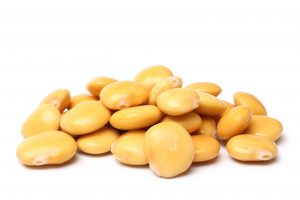Written by: Dr. Jacquie Jacob, University of Kentucky
The seeds of the lupin plant, also referred to as lupins, can be incorporated in poultry diets, but the recommended level of inclusion varies depending on the type of lupin and the poultry species in question. The lupin species most typically incorporated in livestock diets include white lupin (Lupinus albus), blue or narrow-leafed lupin (L. angustifolius), and yellow lupin (L. luteus). Unlike soybeans, lupins do not require roasting before they can be fed to poultry.

The main anti-nutritional factors in lupins are alkaloids, which together with phytates, protease inhibitors, and lectins have led producers to restrict the use of untreated lupin grains in the feed. Breeding for low alkaloid content has resulted in the development of so-called sweet lupins. Sweet lupins can make up 40% of broiler diets with no adverse effects on growth, feed efficiency, or carcass characteristics.
The use of lupins, even sweet lupins, has been somewhat restricted by the level of pectins, indigestible cell-wall polysaccharides, in lupins. Undigested pectins increase the viscosity of the bird’s digestive tract, which in turn reduces dry-matter digestibility, reducing feed efficiency. Pectins also increase water-holding capacity, which leads to increased water intake and wet droppings. Reducing the quantity of lupins in feed can mitigate wet droppings.
The amino acid profile is similar for all three colored lupin varieties, although yellow lupins are higher in cysteine content than the blue or white varieties. The amino acid digestibility of lupins is similar to that of peas and beans (about 85%). The hull represents about 25% of the whole seed. Dehulling lupins increases protein content and energy utilization. Enzyme supplementation (with pectinases) of whole-seed and dehulled lupins improves utilization of the non-starch polysaccharides (NSP) present.
Lupins are adapted to grow in nutrient-poor acidic soils, so most lupin production takes place in areas where other crops struggle. Australia is the dominant producer of lupins, accounting for around 85% of world lupin production. Lupins are also produced in the United Kingdom and western Canada. The high price of organic feed has hampered the development of organic poultry production, resulting in increased interest in organically-grown lupins as an alternative feed ingredient.

